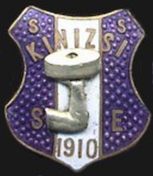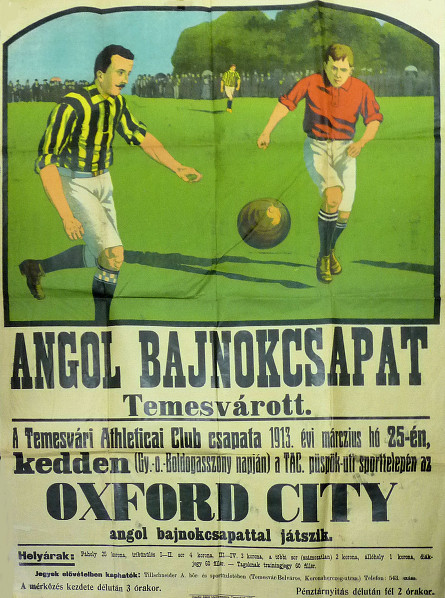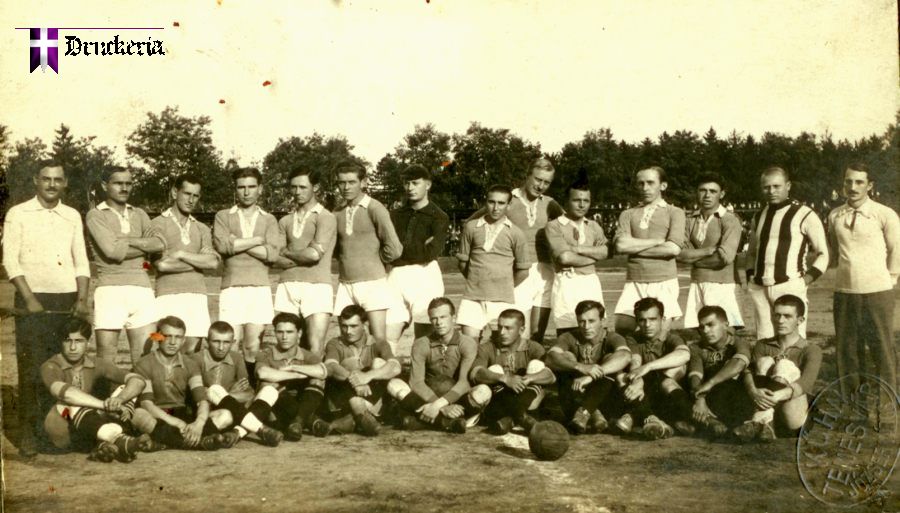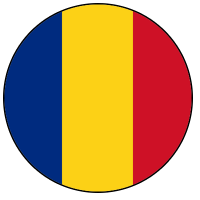 The Banat region, a historical borderland set between the Carpathian mountains and the Danube, Tisza and Mures rivers, is entirely under Austro-Hungarian control. The region has 1.5 million inhabitants, of whom 37% are Romanian, 25% German, 18% Serb and 15% Hungarian. The capital and largest city is the growing industrial centre Temesvár, which is mostly German and Hungarian, but much closer to Belgrade than to Budapest, Vienna or Bucharest. Thanks to its industrial development and its good communication links with the centre of the Empire, football has already been played in Temesvár for over a decade. It is 1910, and a new football club is about to be born into the local sporting scene.
The Banat region, a historical borderland set between the Carpathian mountains and the Danube, Tisza and Mures rivers, is entirely under Austro-Hungarian control. The region has 1.5 million inhabitants, of whom 37% are Romanian, 25% German, 18% Serb and 15% Hungarian. The capital and largest city is the growing industrial centre Temesvár, which is mostly German and Hungarian, but much closer to Belgrade than to Budapest, Vienna or Bucharest. Thanks to its industrial development and its good communication links with the centre of the Empire, football has already been played in Temesvár for over a decade. It is 1910, and a new football club is about to be born into the local sporting scene.
Temesvári Kinizsi SE is named after Kinizsi Pál, a general in the army of Matthias Corvinus/Hunyadi Mátyás (the fifteenth-century King of Hungary) who fought the Turks and was famous for his strength. Kinizsi is the team of the railway workers of the town and they play in white and violet; their first match, in 1911, ends with an 11-0 defeat at the hands of the youth team of the well-established FC Temesvár. Nevertheless, Kinizsi take part in the southern regional division (effectively the Banat division) of the Hungarian league in 1911-12, where they face teams from Szabadka, Szeged, Arad, Nagykikinda and Újvidék, as well as city rivals and defending regional champions Temesvári FC. The following season, presumably due to an increase in applicants, the southern division is split into two and Temesvár teams are put with teams from Arad to the north. In March 1913, the city receives a visit from one of the top amateur sides of England, Oxford City, and hosts Temesvári FC manage to score a goal in a respectable 3-1 defeat.

But they cannot do it as Kinizsi. As Temesvár becomes Timișoara, so Kinizsi is Romanianised to Chinezul. Freed from the dominance of the Budapest clubs, and cut off from Banatean rivals now separated by new national borders – Szabadka and Újvidék are now Subotica and Novi Sad, in Yugoslavia, while Szeged is still within a shrunken Hungary – Chinezul will tower over the teams of the Old Kingdom (pre-war Romania) and supply the new national team with its talent. But they do it almost exclusively with ethnic Hungarians and Germans. The 1911 Chinezul line-up is notable for its German and Hungarian names: Frantz – Villany, Gauner – Nyari, Fischer, Weinhardt – Gáll, Bernhardt, Schuster, Wessely, Pesti. Compare probably their greatest team, of 1926-27: Zombory – Steiner, Hoksary – Teszler, Vogl, Steiner – Tänzer, Teleki, Wetzer, Semler, Matek: still completely un-Romanian. Chinezul supplies seventeen players to the Romanian national team during its six seasons at the pinnacle. On one occasion, a friendly against Turkey in Istanbul in 1926, Romania field ten Chinezul players in the starting XI. However, not once in that time does an ethnic Romanian appear for the club.
From 1921, when the first national finals tournament of Greater Romania begins, until 1941, when World War II interrupts, teams from Timișoara win the title ten times out of a possible twenty, plus two out of seven Romanian Cups. Immediately after the first war a team is founded by the Jewish community, called Kadima; one by the Serb community, Rapid; and several Romanian clubs, including Politehnica, which is established in 1921. In order to qualify for the national finals, seven regional competitions are held across Romania, and the winner of each goes through to a knock-out tournament with the others. Thus Chinezul, as provincial champions, must beat teams from Sibiu and Arad en route to the final against Victoria Cluj; the match, played in Timișoara in front of 3,500 spectators, is won by Chinezul 5-1.

As the 1920s wear on, Chinezul are invited to participate in tournaments and prestigious friendlies abroad. In 1924 they face teams from Czechoslovakia, Austria and Yugoslavia in the Hohe Warte Turnier in Vienna, and in 1926 a Timișoara selection impressively defeats a side representing Budapest. On 1 July 1928, Chinezul are due to play against Șoimii Sibiu in the quarter-final of the national championship. To cover a large hole in the budget, however, the club prefers to send its first team out to play a money-spinning friendly at home against Wiener AC of Austria, on the same day. They earn a creditable draw with WAC, but in Sibiu the reserve team too can only draw; the following day they lose the replay 4-3, and for the sake of 1,200 lei the club’s superb competitive record is also lost. The 1928 championship will be won by Colţea Braşov, last season’s beaten finalists.
That Sibiu fixture marks the start of the fall; a combination of the temptations of professionalism across the border in Hungary, and corruption within the club, leads to plummeting fortunes. The club president, a young lawyer named Cornel Lazăr, sees the future of the game and it is professional. How could it not be? Timișoara is losing players to Hungarian clubs, which have been paying wages to footballers since going pro in 1924. However, professionalism would not be accepted by the Romanian federation at this juncture. Lazăr – who has overseen such sporting success since 1921 – is ousted by some (apparently embezzling) board members and resigns from the club in August.
The first team goes on strike for a time, in protest at the boardroom shenanigans, and consequently Chinezul plays its league games with the reserves. (The first team will, however, happily play friendlies.) Within two months the enterprising Lazăr has founded a new club, Ripensia, which will be the country’s first professional football club. Chinezul’s membership declines steeply. The Romanian federation finally agrees to the game turning professional in 1930 and forms a Central Commission for Professional Football, with Lazăr as president in its Timișoara headquarters. Six Chinezul players jump ship to Ripensia, joining the two who went in the same direction in 1928. At least three former Chinezul players are also reunited with their old team-mates at the new club, along with the two best players of rival local team Banatul Timișoara: Gheorghe Ciolac, who will be captain, and Ștefan Dobay, who will be top scorer, of the all-conquering Ripensia of the 1930s. (But that’s another story, right?)
A high-profile transfer takes place in 1928 which illustrates the bizarre and corrupt nature of these transactions in the inter-war years, while the game in Romania was still officially amateur but Hungary had turned professional. Rudy Wetzer, a Timișorean striker, moves from Chinezul to Ujpest in the Hungarian capital in 1928 thanks to some shady falsification of documents. The fee agreed between the two clubs is 150,000 lei and, after several attempts, Chinezul’s representatives succeed in bribing a former official at the Romanian federation to the tune of 100,000 lei to supply the required international transfer permit. (Apparently, at this time there are roughly 200 lei to the US dollar, and a 1928 dollar has the purchasing power of $13 in 2016, so that works out at the equivalent of around $6500. Chinezul’s entire debt amounts to some 250,000 lei, which is considered enormous for the day.) Wetzer lasts one season in Budapest before getting injured and losing his place in the Ujpest team; in spring 1930 the Hungarian federation gives him a free, no-questions-asked pass back to Romania, where he joins Juventus in Bucharest and immediately helps them to the title.
Chinezul slip into the shadows somewhat after 1928, but resurface in the national championship – by now in league format – in 1933-34. Their best performance is a fifth-place finish the following season… while Ripensia are winning the title. After a couple more seasons in the second tier, and then fusions with various local clubs in the 1940s, the great old Chinezul club finally disappears without a whimper in 1949. By this stage the centre of footballing gravity has definitively shifted away from its old heartland in the north and west of the country, and – along with much else in the centralised, newly Communist country – towards the capital Bucharest. Timișoara will never again be such a force in the game.




